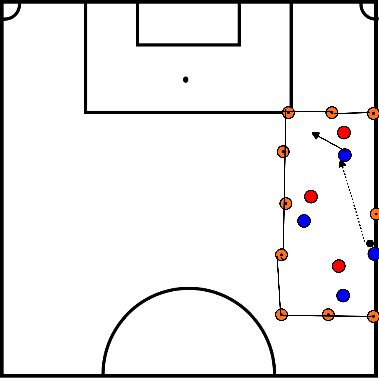Soccer drills for technique positional play
Set out a field for 4 v 4. For example 20 meters wide by 30 meters long.
Create a center line and a goal area with pawns.
A party game 4 v 4 / 5 v 5 or 6 v 6 is played.
You can deepen the game by giving different assignments such as:
1. Free play; no other assignments beyond the normal rules of the game.
2. No goal may be scored until everyone has crossed the center line.
3. A goal may only be scored inside the goal area after an end pass.
4. Hitting 3 times.
5. Crossing an x-number of times before scoring is allowed.
6. Combination of the above.
Create a center line and a goal area with pawns.
A party game 4 v 4 / 5 v 5 or 6 v 6 is played.
You can deepen the game by giving different assignments such as:
1. Free play; no other assignments beyond the normal rules of the game.
2. No goal may be scored until everyone has crossed the center line.
3. A goal may only be scored inside the goal area after an end pass.
4. Hitting 3 times.
5. Crossing an x-number of times before scoring is allowed.
6. Combination of the above.
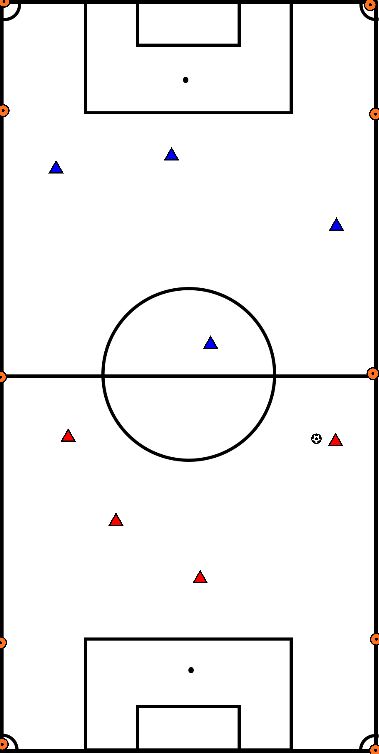
Distances: compartments 3 by 3 meters.
- Everyone stays in their box.
- Red is going to try to score by shooting the ball into one of the goals.
- The defender opposite the player with the ball steps toward him then to put pressure on the ball.
- The other defenders step in to shield the pass line.
Variants:
Harder: make boxes smaller than 3 x 3 meters.
Easier: make boxes larger than 3 x 3 meters.
Harder: make boxes smaller than 3 x 3 meters.
Easier: make boxes larger than 3 x 3 meters.
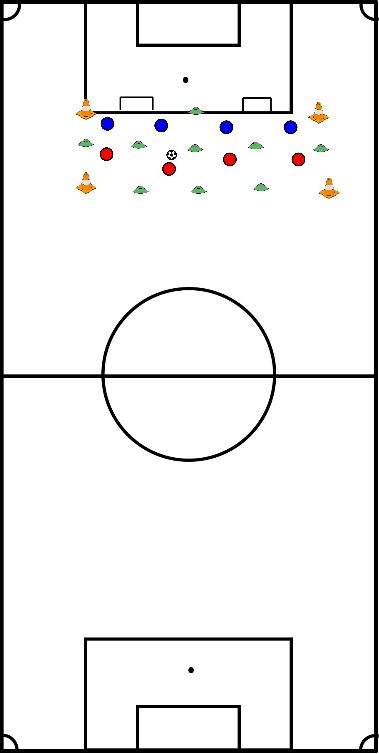
Distance: to the goal 16 meters
Size of squares: 3 by 3.
Assignment:
The defenders try to make it impossible for the attackers to score by shielding the pass lines.
Again, the defender, who has the attacker in front of him, presses with the ball and the rest squeezes in.
The attackers try to get the ball into the 16 to finish.
Rules of play:
Size of squares: 3 by 3.
Assignment:
The defenders try to make it impossible for the attackers to score by shielding the pass lines.
Again, the defender, who has the attacker in front of him, presses with the ball and the rest squeezes in.
The attackers try to get the ball into the 16 to finish.
Rules of play:
- The defenders are not allowed in the attackers' box!!!
- The attackers are allowed into the defenders' box to receive the stabbing ball.
- Once the ball is in the 16, the attackers may score. The defenders may also defend there!!!
- Goalkeeper is free in the 16 to intervene.
- Goal attempt over. Then the attackers become defenders and the defenders get the ball and then join behind as new attackers.
If the attackers cannot get into the 16, you can make it easier for them by making the boxes 1 meter wider.
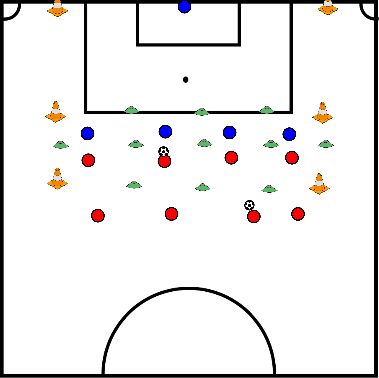
Distances: pawns 2 meters apart.
T= TRAINER.
CV= central defender.
Blue is defense.
Red is offense.
T= TRAINER.
CV= central defender.
Blue is defense.
Red is offense.
Explanation:
Box 1
- Trainer plays ball in to A, the closest man in this case, the CV, step forward to put pressure on player with ball.
- We see a gap created where there is space for the 2 attackers to run in. See the arrows from B&C.
Box 2
- Here we see the solution to cover this running line.
- The moment the defender steps in on the player with the ball, the other players step 1 meter to the middle to close the gap. In this way, no play can be made between them.
- The defender facing the attacker who gets the ball steps forward. The rest must slide inside.
Explanation to players:
- You explain that red are the attackers and blue are the defenders.
- You start in the starting lineup and play attacker A.
- You ask the players; what should the defense do now? Correct answer: opposing defender puts pressure on the man with the ball. Make sure the rest stay put.
- You ask the players; what is created now? Correct answer: space/ running line for the attackers to dive in. Demonstrate this by running one of the attackers into this gap.
- You now ask the players; how can they avoid this? Correct answer: all step in slightly. In this case exactly between the pawns.
Exercise:
- Ball at trainer is always back to beginning lineup.
- Initial exercise is passive, trainer plays to 1 attacker, the defenders take their steps, ball back to trainer.
- Then then play other attacker. Do about 5 minutes until defenders do their job.
- If it goes well quickly, you can make it harder just by increasing the ball pace.
- One step further is to allow the attackers to pass the ball among themselves and not just to the trainer.
- Then switch the attackers and defenders and do the same thing again. Both for about 10 minutes.
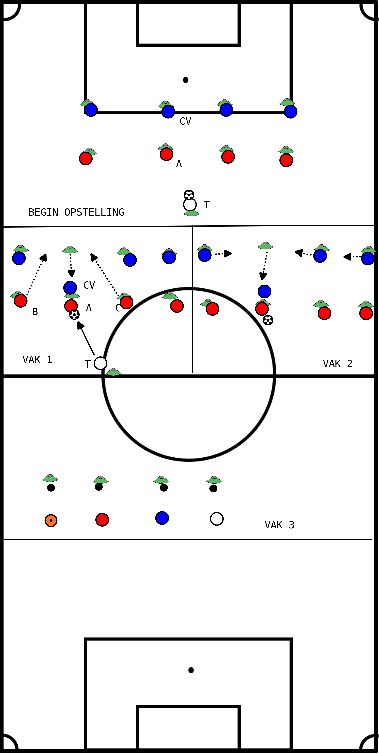
- S2 is central and asks ball to S1.
- S1 plays ball in.
- S2 spins out and does double pass to S3 who asks for ball with pre-action.
- S3 takes ball and does slalom with turn on each side and passes with ball to back pot.
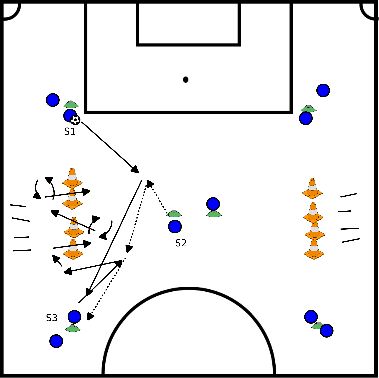
Exercise begins at the two middle cones.
- S1 passes diagonally to S2.
- S2 rebounds to S3.
- S3 rebounds diagonally to S2 who presents at middle cone.
Exercise then continues on the other side.
6 pots, 2 balls and 6 players.
6 pots, 2 balls and 6 players.
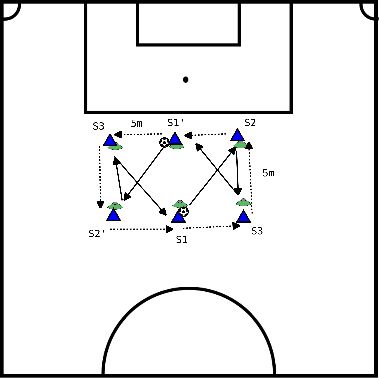
Exercise begins at the two middle cones.
- S1 passes diagonally to S2.
- S2 rebounds to S3.
- S3 rebounds diagonally to S2 who presents at middle cone.
Exercise then continues on the other side.
6 pots, 2 balls and 6 players.
6 pots, 2 balls and 6 players.
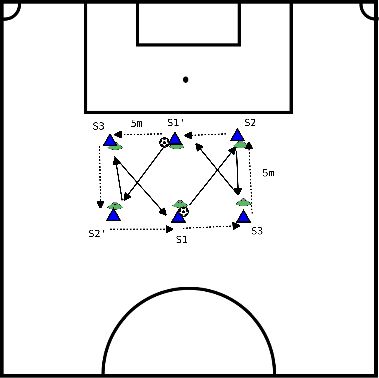
Distances 3 corners 10 meters to make it more difficult reduce the distances.
Distance next triangle 20 meters.
1st triangle:
Distance next triangle 20 meters.
1st triangle:
- A plays B in.
- B plays C in.
- C drops ball on A.
- A gives ball in runs with C towards Pawn.
- Running line A to B , B to C , C becomes A.
2nd triangle:
- A2 plays B2 in.
- B2 passes to C2.
- C2 drops ball on A2.
- A2 plays the ball to D2.
- D2 turns open, plays E2 in.
- E2 plays F2 in.
- F2 drops ball on D2.
- D2 hands ball in, runs with F2 towards Pawn.
- Running line A to B, B to C, C to D, D to E, E to F, F becomes A.
3rd triangle:
- A3 plays B3 in.
- B3 plays C3 in.
- C3 drops ball to A3.
- A3 plays the ball to D3.
- D3 turns open plays E3 in.
- E3 plays F3 in.
- F3 drops the ball on D3.
- D3 plays the ball to G3.
- G3 spins open plays H3 in.
- H3 plays I3 in.
- I3 drops the ball to G3.
- G3 gives ball in runs with I3 towards Pawn.
- Running line A to B . B to C. C to D. D to E. E to F. F to G. G to H. H to I. I becomes A.
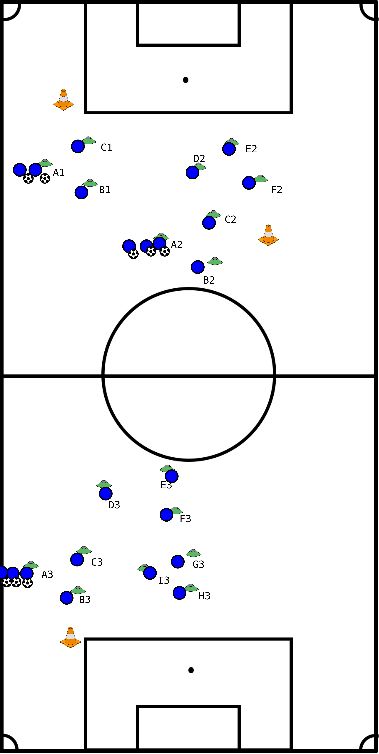
2 attackers against 3 defenders and goalkeeper.
In other group size 3 against 4 or 2 against 1 and so on.
Goal: The goal of the assignment is to have the goalkeeper play the ball into one of the 3 defenders.
In other group size 3 against 4 or 2 against 1 and so on.
Goal: The goal of the assignment is to have the goalkeeper play the ball into one of the 3 defenders.
- The ball starts with the 2 attackers. They play the ball deep to the goalkeeper to have a realistic start.
- The goalkeeper can catch the ball, take it and so on.
- The three defenders must constantly be on the ball.
- The goalkeeper tries to get the ball to one of the three defenders
. - The attackers' task is to block as early as possible to make the build-up by the defenders difficult.
- The task of the defenders is to get the ball over the line by means of play/construction, then again from the start.
When the 2 attackers capture the ball, start again.
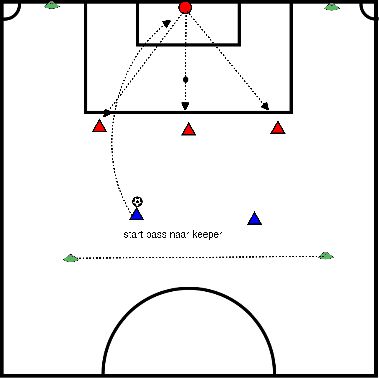
- Duration:
- 20 min
- Distance:
- Width per section 6 mtr length 8 mtr.
- Goal:
- Search for the attacker in possession of the ball and pass to him so that he can score.
- The four players are only allowed to move in their own area to protect the passing line.
- The 2 attackers are free to move around the four squares but behind the defenders.
- When the ball is in the possession of the attacker, the defender can try to conquer it in that square.
- If scoring is too easy, the attackers are obliged to play at least once before they can score.
- When there are more players in the box, you have to add more players.
- When there is an uneven number of players, 1 team works with more attacker but then the rule is immediately in force that the attackers must play at least 1x over before they may score.
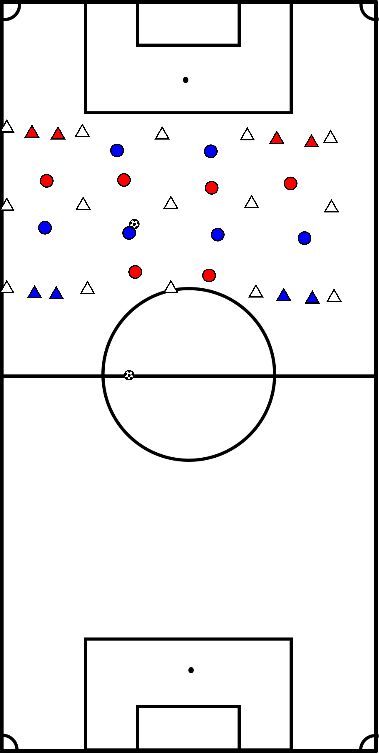
- Improve the position game.
- Blue plays with 3 white and red has to conquer the ball.
- 10 times around blue is one point, two points when played by red.
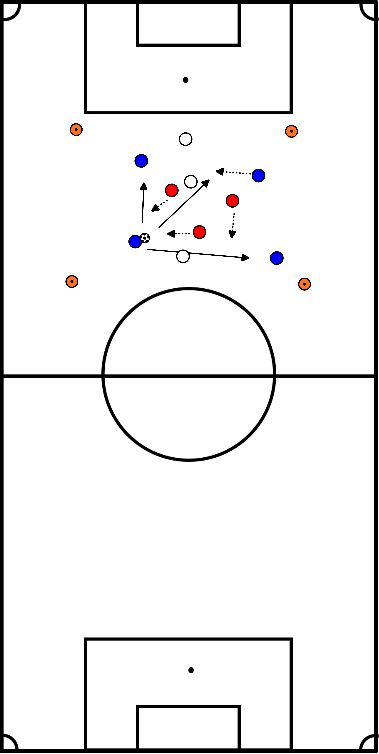
- Bb4 against bbt 3 exercise 10 minutes.
- The aim is for the bb side to dribble the ball over the line or pass it several times. (For example, start at 5 and go higher and higher).
- To make it more difficult they may only touch the ball 2/3 times.
- Bbt side must try to dribble the ball over the opponent's line.
- Or pass 5 times.
- Always play with 1 overtime.
- Adjust the size of the field if it is difficult to play over.
